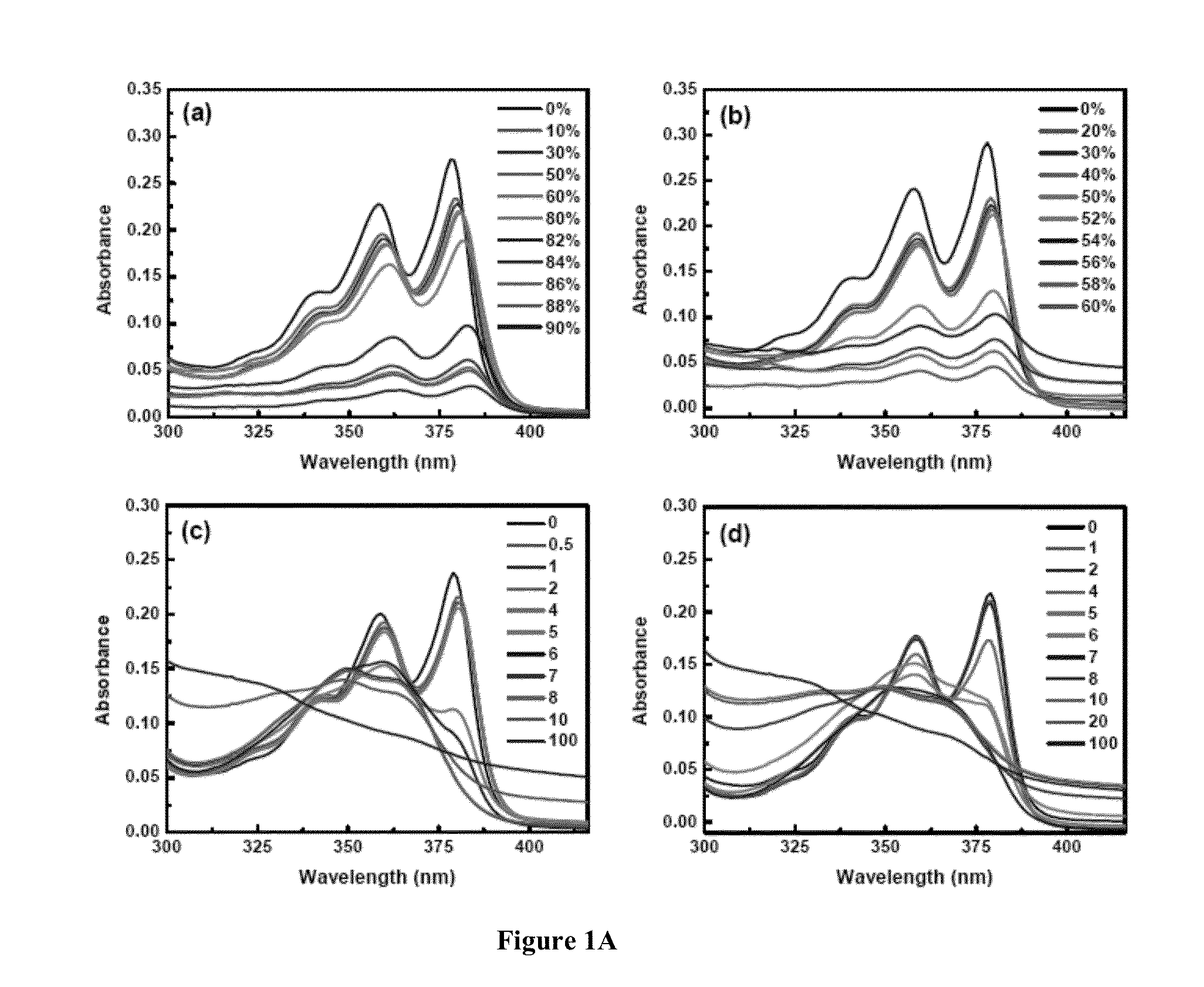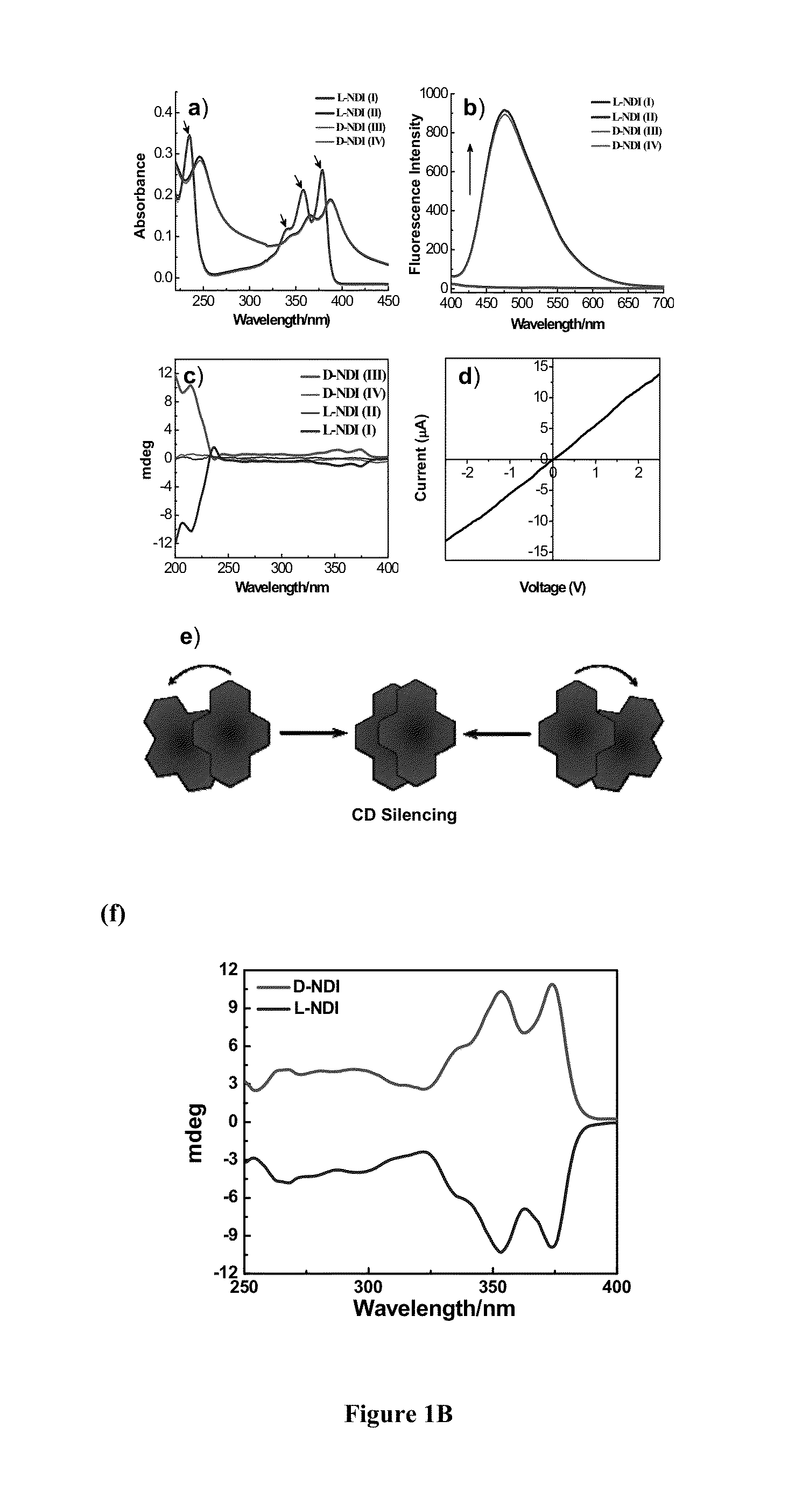Self assembly of naphthalene diimide derivates and process thereof
a technology of naphthalene diimide and self-assembling, which is applied in the field of nanotechnology/nanobiotechnology, can solve the problems of n-type organic semiconductors lagging behind the performance of p-type semiconductors
- Summary
- Abstract
- Description
- Claims
- Application Information
AI Technical Summary
Benefits of technology
Problems solved by technology
Method used
Image
Examples
example 1
Synthesis of Tryptophan Appended Naphthalene Tetra Carboxylicdiimide (NDI 1)
[0122]A modified procedure of Sanders and coworkers has been employed to synthesize NDI 1. 1,4,5,8-Naphthalenetetracarboxylic dianhydride (200 mg, 0.746 mmol) and L-tryptophan (305 mg, 1.491 mmol) are suspended in DMF (20 mL) in a 250 mL Erlenmeyer flask. To this suspension is added 0.2 mL of triethylamine. The suspension is sonicated until the mixture became homogeneous. The reaction mixture is heated under microwave irradiation at full power for 3 min. in steps of 30 sec. and with 30 sec interval. The resulting dark brown oil is taken up into methanol (400 mL). The solution is added under stirring to 600 mL of 1N HCl. The resulting suspension is allowed to coagulate overnight and then filtered through a sintered glass funnel. The solid is then washed with 200 mL deionized water and dried in vacuo to obtain a brown solid of NDI 1. Yield 90%. 1H NMR: (400 MHz, DMSO-d6) δppm 3.46-3.52, (dd, 2H, CH2, J=8 Hz, 8...
example 2
Synthesis of Tryptophan Methyl Ester Appended Naphthalenetetracarboxylicdiimide (NDI 2)
[0123]Synthesis of L-Tryptophan methyl ester hydrochloride: Anhydrous methanol (50 mL) is taken in a 100 mL 2-necked round bottom flask fitted with a reflux condenser and an additional dropping funnel and cooled to ice temperature. Acetylchloride (3 mL) is added drop wise through the dropping funnel. After 15 min, L-tryptophan (3 g) is added and the reaction mixture is refluxed at 70° C. for 6 h. The reaction mixture is vacuo dried to obtain L-tryptophan methyl ester hydrochloride in quantitative yield and used for further reaction without purification. 1,4,5,8-Naphthalenetetracarboxylic dianhydride (200 mg, 0.746 mmol) and L-tryptophan methyl ester hydrochloride (380 mg 1.491 mmol) are suspended in 20 mL of DMF in a 100 mL round bottom flask. To this suspension is added 0.5 mL of triethylamine under inert atmosphere. The reaction mixture is refluxed at 65° C. for 21 h. Solvent is evaporated under...
example 3
Synthesis of L-Phenylalanine Methylester Appended Naphthalenediimide (L-NDI or NDI 3A): Synthesis of L-Phenylalanine Methylester Hydrochloride
[0124]Anhydrous methanol (50 mL) is taken in a 100 mL 2-necked round bottom flask fitted with a reflux condenser and an additional dropping funnel and cooled to ice temperature. Acetyl chloride (3 mL) is added drop wise through the dropping funnel. After 15 min, L-phenylalanine (3 g, 18.16 mmol) is added and the reaction mixture is refluxed at 70° C. for overnight. The reaction mixture is vacuo dried to obtain L-phenylalanine methylester hydrochloride in quantitative yield and used for further reaction without purification.
[0125]1,4,5,8-naphthalenetetracarboxylic dianhydride (200 mg, 0.74 mmol) and L-phenylalanine methylester hydrochloride (322 mg 1.49 mmol) are suspended in DMF (20 mL) in a 100 mL round bottom flask. To this suspension triethylamine (0.6 mL) is added under inert atmosphere. The reaction mixture is refluxed at 75° C. for 24 h....
PUM
| Property | Measurement | Unit |
|---|---|---|
| temperature | aaaaa | aaaaa |
| temperature | aaaaa | aaaaa |
| length | aaaaa | aaaaa |
Abstract
Description
Claims
Application Information
 Login to View More
Login to View More - R&D
- Intellectual Property
- Life Sciences
- Materials
- Tech Scout
- Unparalleled Data Quality
- Higher Quality Content
- 60% Fewer Hallucinations
Browse by: Latest US Patents, China's latest patents, Technical Efficacy Thesaurus, Application Domain, Technology Topic, Popular Technical Reports.
© 2025 PatSnap. All rights reserved.Legal|Privacy policy|Modern Slavery Act Transparency Statement|Sitemap|About US| Contact US: help@patsnap.com



